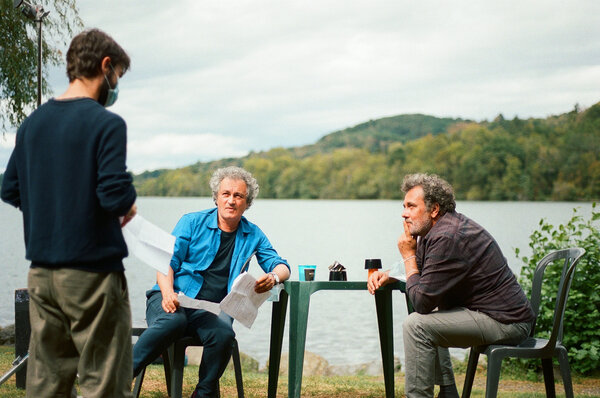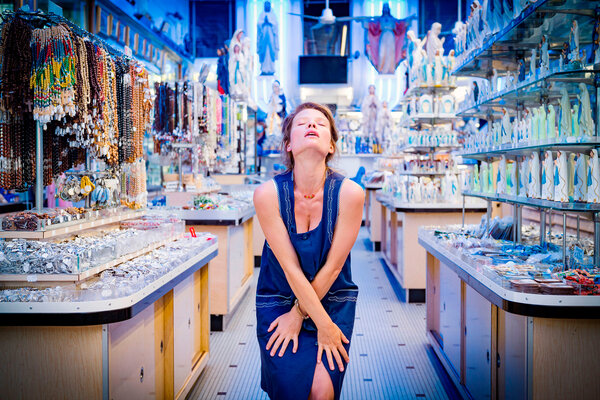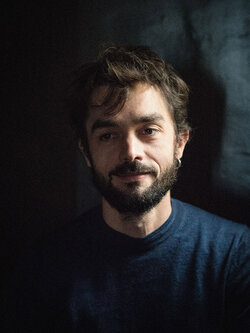Jonathan Ricquebourg, AFC, discusses his work on the Larrieu brothers’ film "Tralala"
A Parisian in LourdesHow did the Larrieus introduce their film to you ?
Jonathan Ricquebourg : The initial idea was to start with a realistic film, and then to slip gradually into a musical comedy as Tralala invents himself a new character. This is why the film begins with a handheld camera, shorter takes, and sometimes jump cuts. The opening itself, where Tralala wakes up in his squat while saving ideas of lyrics for a composition, is the best example of this. But no matter what, the Larrieu brothers are always concerned with the realism of their films : the situations, the places, the lighting… they are clearly influenced by Godard and other New Wave filmmakers. This isn’t at all the world of Vincente Minelli’s musical comedies.

And yet, that scene is one of the few that looks like it was shot in studio, don’t you agree ?
JR : Yes, that’s true. But it wasn’t shot in studio. But the artificial sunlight through the blinds and the bit of smoke in the air do indeed give off that impression. I think that that scene was my tribute to An American in Paris when Gene Kelly wakes up in the attic… It’s a very Hollywoodian vision of a Parisian chambre de bonne !
When Tralala meets Lili (Josiane Balasko), this represents a shift in the story…
JR : That’s when the film begins to shift definitively into a musical comedy. The viewer discovers that all the characters are going to begin singing and that the singer is going to become someone else. This is an important scene, in which the Larrieus initially wanted to film Josiane Balasko as a blurry shape at first. Like something abstract that signals the shift in the film. In reverse shot, the decision to place Mathieu Amalric in bright lighting then became logical. I orchestrated a soft increase in lighting that follows Tralala’s acceptance of this new character as his mother, which allows him to see her face. At this point in the film, the viewer has no idea whether or not Tralala is actually Pat…or is he ?
But Pat…is you !
JR : Yes, he is me ! The brothers thought that of everyone in the crew, I was the one who most looked like a past version of Tralala… So, out of kindness, I accepted to play the cameo via the little photograph.
How did shooting go ?
JR : They are filmmakers who work shot-by-shot. It’s rare for them to conceive of a scene in its entirety. They literally piece together their film like artisans, shot by shot. As a DP, you see that it’s hard to ask them to group the wide-angle shots together and then to group the close-ups together, for example, even though the logic of shooting would require that. They might very well begin with a close-up that they feel is essential, and then shoot a wide tracking shot, and then go back to filming close-ups depending on how things go.

How long did shooting take ?
JR : It took 27 days. Two days at Paris to start, and then the rest at Lourdes, between September and October 2020, just before the second lockdown. Everything was shot on location, and I must say that the pandemic made it much easier for us to shoot this film ! Tourists had mostly deserted the streets, and we had total access to everything !
I was able to have the streets wetted, work in hotels (such as the Grand Hôtel de la Consolation, where a part of the action takes place) and shops. An example of the latter is Mélanie Thierry’s choreographed song, which takes place in a souvenir shop, and which I think came off very well.

Some of the colors are very stark in this film…
JR : Because they like Godard, they like slightly flattened primary colors. At the same time, their obsession with realism often stops them from overly saturated things. But in that scene, as in others that use the city’s colors (blue and white), we really went for it. At the same time, the shop is full of blue and white statues of the Virgin Mary, and we couldn’t get away from it ! There’s another scene where I also played with very saturated lights to twist the natural lighting, which is the scene in Room 617, with the song sung by Maiwen. On that location, my idea was to make the room match the club location.
There are also some dialogues covered in face-to-face 180° shots, like the one in the forest between Tralala and Jeannie. Isn’t that an iconoclastic approach ?
JR : They like filming that way. That also happened on the balcony, immediately after Josiane and Mathieu’s reunion. For the scene between Tralala and his former lover, Jeannie, I chose not to compensate for the backlight at all. The actors are silhouetted, and the 180° reverse shot is directly facing the light. It’s raw and without artifice. It makes me think about the question of artificiality on screen. Going from shot to reverse shot in a dialogue is natural… Yet, the viewer’s eye is so used to having the DP compensate for that effect by reflectors and diffusions, so much so that the natural suddenly becomes a staged effect… It’s truly a question of semiology, isn’t it ?
And why Scope ?
JR : I thought anamorphic was a requirement for a musical comedy. As I re-watched Jacques Demy’s films, amongst others, I thought that the Scope would set the right tone and keep the lighting sober. In retrospect, I’m realizing more and more that I prefer sets to be as perfect as possible, with the least number of transformations or improvements possible, in order to simply take advantage of the perfection of what is real. For example, bringing small warm lights into the background of an indoor night scene does indeed make the scene easier to light. But it makes the film feel more artificial. In keeping with that idea of respecting reality, I chose the Arri Master Prime Anamorphic lenses, which is a series that doesn’t overly stylize the image. Those lenses have excellent color separation, are very sharp, and few or no aberrations. That was important to me because the locations were tight, and I didn’t want problems with some shots filmed using a wide lens.
What is your takeaway from this film ?
JR : Up to this film, I hadn’t shot many naturalistically-lit scenes. For example, Scheherazade was a very stylized film, and was pushed far from reality. I was glad to have the opportunity of working differently. What a pleasure to film faces like those of Mathieu Amalric, Josianne Balasko, and Mélanie Thierry. Also, shooting with music and dancing gives the images a particular tonality.
Tralala, a forty-something Parisian street singer, meets a young woman one evening who gives him a single message before disappearing : “Do anything except be yourself”. Was it a dream ? He leaves the capital and ends up finding the woman he has already fallen in love with at Lourdes. She no longer remembers him. But a moving sixty-year-old woman believes that Tralala is her son, Pat, who disappeared twenty years prior in the United States. Tralala decides to play the “role”. He discovers a new family and the inspiration he never had.
Interview by François Reumont translated from French by A. Baron-Raiffe, for the AFC.
 En
En Fr
Fr






